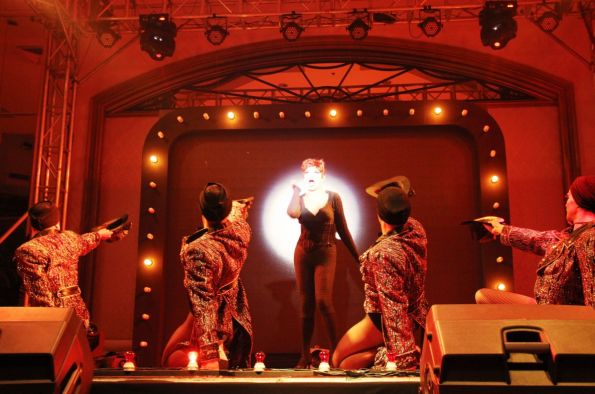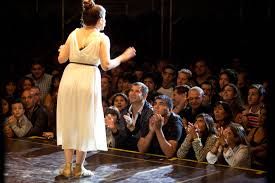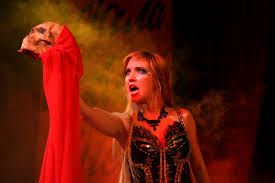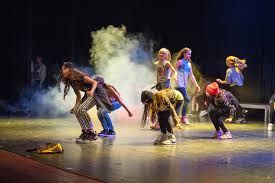American Theater – Characteristic, Concept and Development
Contents
What is the American Theater?
The history of the American theater dates back as early as the second half of the 17th century, when there is evidence of its performance attempts, among some of the less puritanical of the early American colonies. Thus, the first real theaters were those built in Williamsburg in 1716, New York in 1732 (with the opening of Farquhar’s comedy “The Official Recruit”) and Charleston in 1736. None of them remained in use more than a few seasons after their initial openings.
Likewise, it was in 1750, when the American theatrical tradition took hold and had polarized around the two liberal cities of Philadelphia and New York, in the case of North America, which are known to have had established companies at that time, while elsewhere consistent Puritanism still influenced limited theatrical development.
How did the American Theater develop?
The history of theater in America begins at the time of breaking ties with the colonies of Spain. William Dunlap, the earliest historian of the American stage, states that drama was introduced into this country by Hallams in the year 1752 when they brought a company from London and presented the Merchant of Venice in Williamsburg, then the capital of Virginia, in a building arranged for it.
However, Dunlap was informed of a well authentic dramatic theatrical number that had been given in different parts of the colonies many years before the arrival of the Hallams. He apparently knew nothing of the theater built in Williamsburg, Virginia, in 1716 and therefore had no knowledge of the theater opened in New York in 1732. Likewise, he makes no mention of the opening of the cottage on Dock Street, Charleston, in 1736, nor had he heard of Thomas Kean, in the performance of Richard III, at the first street theater in Nassau, New York, in 1750.
Virginia is considered by some to be the birthplace of Indian theater, however, it is believed that 1752 is not the date of the birth of drama in this country, since there were theatrical performances in Williamsburg and performances in New York by professional actors many years before this theater.
Thus, it is known that a regular theater was built in Williamsburg and performances staged, as early as 1716. It is also known that Murray and Kean were the theater company of professional actors who performed Richard III in Williamsburg some time before the Hallams arrived and presented the Merchant of Venice. In fact, the Hallams used the same theater that had been occupied by the Murray-Kean company.
In this sense, even in spite of the scarce information on the performances and actors of the American theater, in the pre-revolutionary press and chronicles of the time, it would have been impossible to try to determine when or where the first theatrical performance took place in the northern part of the American continent.
Therefore, it is believed that there were dramatic theatrical performances of this species of theater scattered throughout the colonies many years before records were kept. Particularly in the south where the prejudice against the tablas was less violent than in the north. Much stronger, however, was the prejudice in the Puritan provinces of New England where the first actual records of public theater are found and in Quaker, Philadelphia where the drama found a permanent home.

What little is known of the beginnings of acted drama in America is not surprising, when one considers the intolerance of the time against theater and actors. In the face of almost general condemnation of the theatrical houses, the newspapers were encouraged not to give space in their columns, to folk-theater performances.
It was also customary at the time for the actors themselves to distribute pamphlets in the homes of prospective theatergoers and thus arouse interest in the plays offered, instead of relying exclusively on newspaper advertising as is the modern practice. These reasons, perhaps, account for the almost total absence of theatrical news in the pre-revolutionary press, which has made the historian’s researches extremely difficult.
In the South the colonists had imported a taste for the drama along with their other English customs, but in the North the playhouse was still considered the highway to hell and was everywhere fiercely condemned, to the extent of being prohibited under the severest penalties. In 1750 the general court of Massachusetts passed a law prohibiting stage performances and theatrical shows of any kind.
Accordingly, on May 31, 1759, the house of representatives in the colony of Pennsylvania passed a law prohibiting theatrical exhibition and performance with heavy fines. In 1761 Rhode Island brought out a sort of act, to prevent theatrical acts and other theatrical entertainments within the colony, and in the following year the house of representatives of New Hampshire refused the admission of the acting company on the soil of Portsmouth, because it had a peculiar influence on the minds of the young and endangered their morals, giving them a taste for intrigue, amusement and pleasure.
In 1824 President Dwight of Yale College in his essay on the theater, declared that to enjoy plays meant nothing more and nothing less than the loss of the most valuable treasure was the immortal soul. Even as late as 1856, when the city of Brooklyn could boast of being the city with the only theater, there was considerable opposition to the word “theater,” finally achieving its recognition by making it look like an Academy of Music.
Similarly, Judge Daly tells an amusing anecdote relating to a preliminary rehearsal of this new art, in which there was a hot discussion among the building committee on questions of stage and scenery, in a decided stand against a curtain.
Thus, so unversed in the history of the theater was this worthy city father that it was necessary to explain to him that stage in the theater referred to what generally divides the sections of the theater, commonly called “acts” and that the curtain was simply reduced to marking these spaces.
In this connection, it is important to note that while the great majority of the northern settlers were strongly opposed to the theater on religious and moral grounds, there was a large and growing class of important centers who were loaded with no scruples, people of means and leisure who had just crossed the Atlantic and who, when they sought recreation, naturally did so at the theater, this form of amusement being very popular in the country.
It is not unreasonable, then, to suppose that in the colonies which grew in importance, and communication between America and Europe became more frequent, the ancient spirit of irreconcilable intolerance which placed an interdiction on all secular amusements, including the theater, was afterwards considerably modified, especially in the important cities. Therefore, the citizens of these communities, in their leisure moments, undoubtedly craved the pleasures of the theater, arriving from London on every ship.
What are the types of American Theater?
The most famous men in England wrote plays and attended their performance. The principle of the theater was wit and learning, while fashion, beauty, taste and refinement, of the proud and exclusive aristocracy of the land, took their places in the boxes of the stage, surrounding the set of poets and critics below.
Drama in the American Theater
The drama in England, and then carried to America, gradually emerged from the depths into which it had sunk after the Restoration. Under the leadership of Addison, Pope, Steele, and Swift began the so-called “Augustan Age” of English literature. Dryden, hailed as a new Shakespeare, had already given the stage vigor and brilliance to the theater. Likewise, Addison, producing his Cato, was considered the best example of classical tragedy, at a time of great political exaltation, which met with extraordinary success, drawing praise even from the cynic Voltaire.
Exactly when the first dramatic performance was given in America is impossible to say. There are records in Virginia of a play being acted in that Colony. However, this was only a beginner’s effort at theatricality.
Tragedy in the American Theater
Thomas Otway’s tragedy, Venus Conservative, had earned the title of “Euripides of the English stage.
Then in America in 1690 Harvard students gave a performance in Cambridge, Massachusetts, of Benjamin Colman’s tragedy. Gustavus Vasa, wrote the first libretto, American acted in America, of which we know. It is also known that these scripts were dramatic performances, done by professional actors in New York in the early 18th century.
Thus, Anthony Aston, was a well-known English actor-adventurer, who performed in New York, about 1702 and it is known that not only were theatrical performances at the time of his visit not taboo, but were already a popular feature of New York life.
Comedy in the American Theater
Wycherley made all London laugh with his masterpiece, The Country Wife and the Simple Bargainer. Likewise, Congreve, the greatest English master of pure comedy, had produced his coronation and triumph in love for love’s sake.
Farquhar’s Witty Comedy, written in Marlborough’s victory, at a time when all England was ablaze with the martial spirit that was occupying every town, was a very popular play during the eighteenth century and continued to be acted until about thirty years ago. This play was on the border lines of the indecency and mockery to which modern audiences are accustomed. However, the joy and good humor of the piece seeks to make ample amends for what may lack propriety.
Likewise, Leigh Hunt considered one of the best performances of Farquhar’s theater, was later revived at the Park Theatre, New York, in 1843 and again by Augustin Daly in 1885 when John Drew was seen as the dashing Captain Plume, a role originated by the celebrated Wilks, and Ada Rehan acted as Sylvia, a part originally acted by the famous Mrs. Oldfield.
What is the legacy of the American Theater?
The most important contribution of all American theater is theater as an art in which a conglomerate of different arts converge. These arts are the visual arts in scenography, costumes and the auditory arts such as poetry and music. Also the art of the American theater, added time and space to the theater turning it into a temporary art, since it implies a spectacle that begins at a certain hour and ends two or three hours later.
At the same time the American theater, transformed the scenography of the theater, because to gather an audience and before them a group of actors, it was necessary a fixed and predetermined place. Another legacy of the American theater is the incorporation of other varied arts such as scenography that incorporates painting, architecture, lighting, costumes, makeup and characterization, dance and choreography and other skills to the delight of the audience, in the performance. In which the body, voice and intelligence are put at the service of the vision that the author wanted to convey to the public.
By creating the figure of the director, the American theater, develops because the responsibility for the coupling of so many diverse elements and arts falls to this director, whose significance and preeminence has determined the recent improvement of this art of stage presentation. Along with all these artists participating in the presentation of the work, we must mention the technicians who, under the orders of the director, make the desired effects possible. Carpenters, stagehands, electricians, sound technicians, tailors, scenographers, among others.
Who are the main representatives?
Thomas Betterton, the great Shakespearean actor and all the famous actors of the restoration went far beyond their degree of maturity. However, there was a new generation of actors such as Wilks, Cibber, Mrs. Porter, Peg Woffington and others, equally as celebrated who rose to take their places. Likewise, Barton Booth’s tragic day, was so popular that he was admitted to the patent, while Ann Oldfield, the waitress became the associate of duchesses, was the reigning attraction at Drury Lane.
Likewise, Macklin, departing from tradition, had thrilled London by acting Shylock for the first time as a tragic character. In the same year David Garrick, the first actor of his age, made his debut at Goodman Fields as Richard III.



